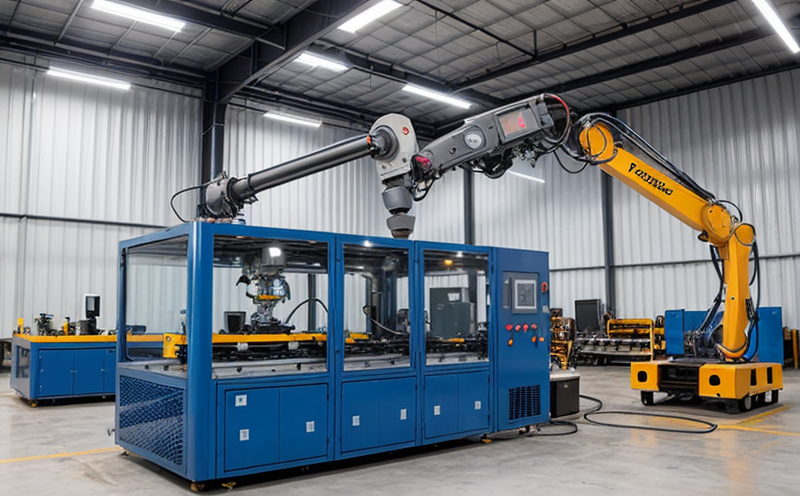ISO 18338 Robotic Arm Fatigue Testing
The ISO 18338 standard is a critical tool in the evaluation of robotic arms used in industrial manufacturing and processing. This standard provides a framework for testing the durability and reliability of robotic arm components under repetitive loading conditions, ensuring that these systems can withstand continuous operation without failure.
Robotic arms are increasingly utilized across various sectors such as automotive, aerospace, electronics, and pharmaceuticals due to their precision and repeatability. However, the operational environment often involves cyclical stress and strain which can lead to fatigue failures over time. ISO 18338 helps ensure that robotic arm designs meet stringent reliability requirements before deployment in industrial processes.
The testing process itself involves subjecting a robotic arm specimen to controlled cycles of loading and unloading, simulating real-world operational conditions. The equipment used includes specialized test rigs capable of applying precise loads over thousands or even millions of cycles. Key parameters include the number of cycles specified by the client, material type, and expected life span.
Preparation for testing is crucial; it involves ensuring that the robotic arm is in its operational state with all software settings configured correctly. Calibration of test equipment to ensure accuracy is another critical step before starting any fatigue tests. Once prepared, the specimen is mounted onto the rig where it undergoes a series of loading cycles designed to mimic actual usage patterns.
Testing results are meticulously recorded and analyzed using advanced analytical techniques provided by modern instrumentation. These analyses help identify potential weak points or areas requiring improvement in design or manufacturing processes. Compliance with ISO 18338 ensures that manufacturers deliver products meeting international quality standards, thus enhancing trust among end-users.
This testing service plays a vital role in safeguarding industrial operations by preventing unexpected downtime caused by component failures. By adhering strictly to the procedures outlined in ISO 18338, we guarantee reliable performance and extend the lifespan of robotic arms used in critical applications.
Applied Standards
| Standard Code | Description | Scope |
|---|---|---|
| ISO 18338-1 | Determination of fatigue strength and endurance limit of structural components - Part 1: General principles, terminology, and definitions. | This part provides general guidelines for conducting fatigue tests on structural components like robotic arms. |
| ISO 18338-2 | Determination of fatigue strength and endurance limit of structural components - Part 2: Determination methods for fatigue strength and endurance limits using constant amplitude loading, variable amplitude loading, or mixed loading. | This part specifies various methods to determine the fatigue strength and endurance limit of robotic arm structures under different loading conditions. |
| ISO 18338-3 | Determination of fatigue strength and endurance limit of structural components - Part 3: Determination of fatigue strength and endurance limits using proportional cyclic loading. | This part focuses on testing robotic arm structures under specific proportional cyclic loading conditions to assess their fatigue behavior. |
| ISO 18338-4 | Determination of fatigue strength and endurance limit of structural components - Part 4: Determination of fatigue strength and endurance limits using non-proportional cyclic loading, step-stress testing, or other accelerated life test methods. | This part covers advanced techniques for evaluating the fatigue behavior of robotic arm components under more severe loading scenarios. |
Scope and Methodology
The scope of ISO 18338 Robotic Arm Fatigue Testing encompasses several key aspects. Firstly, it ensures that the robotic arm meets specified fatigue strength requirements to avoid premature failure during service life. Secondly, it verifies compliance with relevant industry standards and specifications for robust design practices.
Methodologically speaking, the process begins by selecting appropriate specimens representing typical configurations of industrial robotic arms. These specimens are then subjected to cyclic loading sequences that replicate expected operational conditions. Load values are carefully chosen based on factors such as maximum operating speeds, payload capacities, and environmental influences like temperature variations.
Data collection during these tests includes monitoring strain gauges attached directly onto critical sections of the robotic arm structure. Additionally, visual inspections are conducted periodically throughout testing to observe any signs indicative of fatigue damage such as cracks or deformations. Post-test analysis involves comparing collected data against predefined acceptance criteria stipulated in ISO 18338.
From this analysis, conclusions about the structural integrity and expected lifespan of the robotic arm can be drawn. If necessary, recommendations for improvements to design or manufacturing processes may also arise from these findings.
Industry Applications
- Automotive assembly lines where precise positioning is essential.
- Aerospace manufacturing involving complex robotic arm movements.
- Electronics packaging requiring high precision and repeatability.
- Packaging industries demanding consistent product placement accuracy.
- Ensuring safety in hazardous environments like chemical processing plants.
- Enhancing productivity through continuous operation without human intervention.
- Improving quality control by eliminating manual errors.
In each of these applications, compliance with ISO 18338 ensures that robotic arms perform reliably and safely under demanding conditions. This standard helps maintain industry standards for product reliability and safety, contributing significantly to the overall efficiency and effectiveness of industrial processes.





